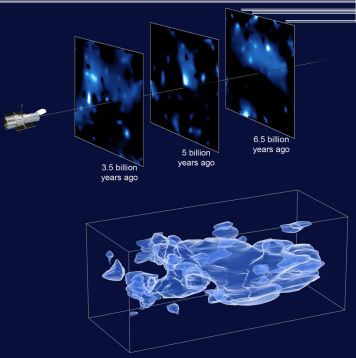A team of 70 astronomers processed the Hubble measurements

A team of astronomers has created a XNUMXD map of the distribution of dark matter throughout the universe. The map provides some of the best evidence that the normal matter, which makes up the stars, planets, animals and plants, and humans, gathers around the denser regions of dark matter.
The map was made through a comprehensive survey made with the Hubble Space Telescope, known as the Cosmic Evolution Survey. A team of 70 astronomers measured the shape of about 500 galaxies photographed as part of the survey and looked for subtle disturbances in them. These disturbances originate from the curvature of gravity created by the disturbing dark matter. The more distorted the shape, the greater the proportion of dark matter in that area.
The conclusion of the study is that the dark matter started out uniformly distributed in the universe, then began to collapse into clumps into a kind of coils. At the heart of those coils we see the greatest concentrations of ordinary matter.
For the news in Universe Today

2 תגובות
There is a possibility that the universe will stop expanding if there is enough material to slow down the expansion. If not, then it will continue and continue to expand. This dark matter makes up more than 90% of the universe. Another thing about the big bang is that it is not an appropriate name for the beginning of the universe. The universe began full of nothing without time and without space. It could be that there was an oscillation from nothing that caused the formation of a tiny spot that crossed was almost infinite. A second later, particulate gases of all kinds spread in space. The heat of the spot dropped to thousands. We also understand a small star that seems to have no units whatsoever, but thanks to the astoids and the years of evolution, here we are discussing the formation of this amazing substance
In addition to the distribution, possibilities for homogeneity and heterogeneity must be taken into account, as examples of homogeneity from the non-dark matter:
The diamond which is an atomic lattice, where the carbon atoms in its crystal are arranged in tetrahedra. And this is as long as it is not damaged by various impurities (mainly nitrogen).
Gold being characterized by the great difficulty to combine with other materials.
on the heterogeneous materials; Theoretically, they have no end.